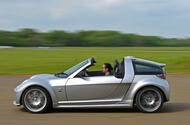What makes the Smart Roadster so appealing to car enthusiasts today?
Ask anyone who’s spent time behind the wheel of a Smart Roadster and you’ll hear a mix of gripes and grins. For all its quirks, the Roadster has become something of a cult favorite among enthusiasts who crave something different. It’s not just about the price—though the fact that you can now pick one up for as little as £2000 certainly helps. The real draw is its personality. This is a car that stands out in a world of lookalike hatchbacks and SUVs. Its compact, low-slung body, mid-engine layout, and playful design cues make it feel special, even before you turn the key.
But it’s not just about looks. The Roadster’s 698cc turbocharged triple engine, borrowed from the Smart Fortwo, delivers a surprising punch for its size. With just 815kg to move, the 80bhp on tap feels genuinely lively. The car’s lightness translates into a nimble, tossable feel on the road—at least until the electronic stability program (ESP) steps in to keep things sensible. Sure, it’s not a Lotus Elise, but it’s not trying to be. The Smart Roadster is about accessible fun, not lap times.
How does the Smart Roadster’s driving experience compare to other small sports cars?
Let’s be honest: the Roadster’s automated manual gearbox is a bit of a party pooper. Gear changes come with a noticeable pause, and if you let the transmission do its own thing, you’ll find yourself caught off guard by the sudden loss of power as it swaps cogs. The trick? Take control. Use the manual mode, anticipate the shifts, and you’ll quickly learn to smooth out the interruptions with a dab of throttle. Some owners even opt for the optional paddle-shift sports wheel, which makes the whole process a bit more engaging.
Steering is another mixed bag. At first, the Roadster feels eager to dart into corners, but push harder and its initial sharpness gives way to a more muted response. It’s not understeer exactly—just a reminder that this isn’t a track-bred machine. Still, the low center of gravity and minimal body roll keep things entertaining. And while the ESP can be a little overprotective, it’s a small price to pay for the peace of mind, especially given Smart’s history with more, let’s say, “excitable” models.
What are some unique design features that set the Smart Roadster apart?
The Roadster’s construction is a testament to Smart’s willingness to take risks. Its Tridion safety cell—a pressed steel tub that forms the backbone of the car—anchors the suspension and powertrain, while colorful composite panels give it a playful, modular look. Inside, the cabin is just as distinctive. Dashboard panels are covered in non-reflective cloth, available in a range of shades (including a cheerful orange, if you’re feeling bold). The instrument pods are so sculpted and tactile, you’ll be tempted to pick them up and take them home.
Then there’s the roof. The standard Roadster features a targa-style setup with a roll-back fabric panel that opens the cabin to the sky in seconds. For a true open-air experience, you can remove the side panels and stow them under the bonnet. The Roadster Coupé, with its curvy fastback rear, adds a dash of visual drama and a bit more practicality.
What should potential buyers look out for when considering a used Smart Roadster?
Like any car with a bit of age and character, the Smart Roadster comes with its own set of foibles. Water leaks are a known issue, especially around the roof and windows. Early cars were notorious for letting in the rain, which can lead to electrical gremlins if left unchecked. It’s worth checking for signs of damp carpets or musty smells before buying.
The gearbox, as mentioned, is a love-it-or-learn-to-live-with-it affair. Make sure it shifts smoothly in both automatic and manual modes. Some owners report that a software update or a skilled technician can improve shift quality, but don’t expect miracles.
On the plus side, the Roadster’s mechanicals are generally robust. The turbocharged engine is lively and, with regular maintenance, can rack up impressive mileage. Parts availability is decent, thanks to shared components with other Smart models. And because the car is so light, brakes and tires tend to last longer than you might expect.
How has the Smart Roadster’s reputation changed over time?
When it launched, the Roadster was something of an oddball—expensive for its size, with a reputation for leaks and warranty claims that reportedly cost Mercedes up to €3000 per car. Production lasted just three years, with only 43,400 units built. At the time, it was seen as a bit of a misfire.
Fast forward two decades, and the narrative has shifted. What was once a pricey curiosity is now a rare, affordable gem. Prices for good examples start around £2000, while pristine Brabus versions or low-mileage survivors can fetch up to £6000. That’s a small price to pay for a car that delivers so much character and fun.
Is the Smart Roadster a future classic?
All signs point to yes. The Roadster’s limited production run, distinctive design, and undeniable charm have helped it carve out a loyal following. Enthusiasts appreciate its blend of practicality and playfulness—a car that’s just as happy zipping through city streets as it is taking the scenic route home. It’s not perfect, but that’s part of the appeal. The flaws are quirks, not deal-breakers, and they give the Roadster a personality that’s hard to find in modern cars.
The big takeaway? Enjoying a Smart Roadster isn’t about perfection—it’s about smarter adjustments. Start with one change this week, whether it’s mastering the gearbox or fixing a leaky seal, and you’ll likely spot the difference by month’s end. The result? Pure magic, with a side of sunshine.

